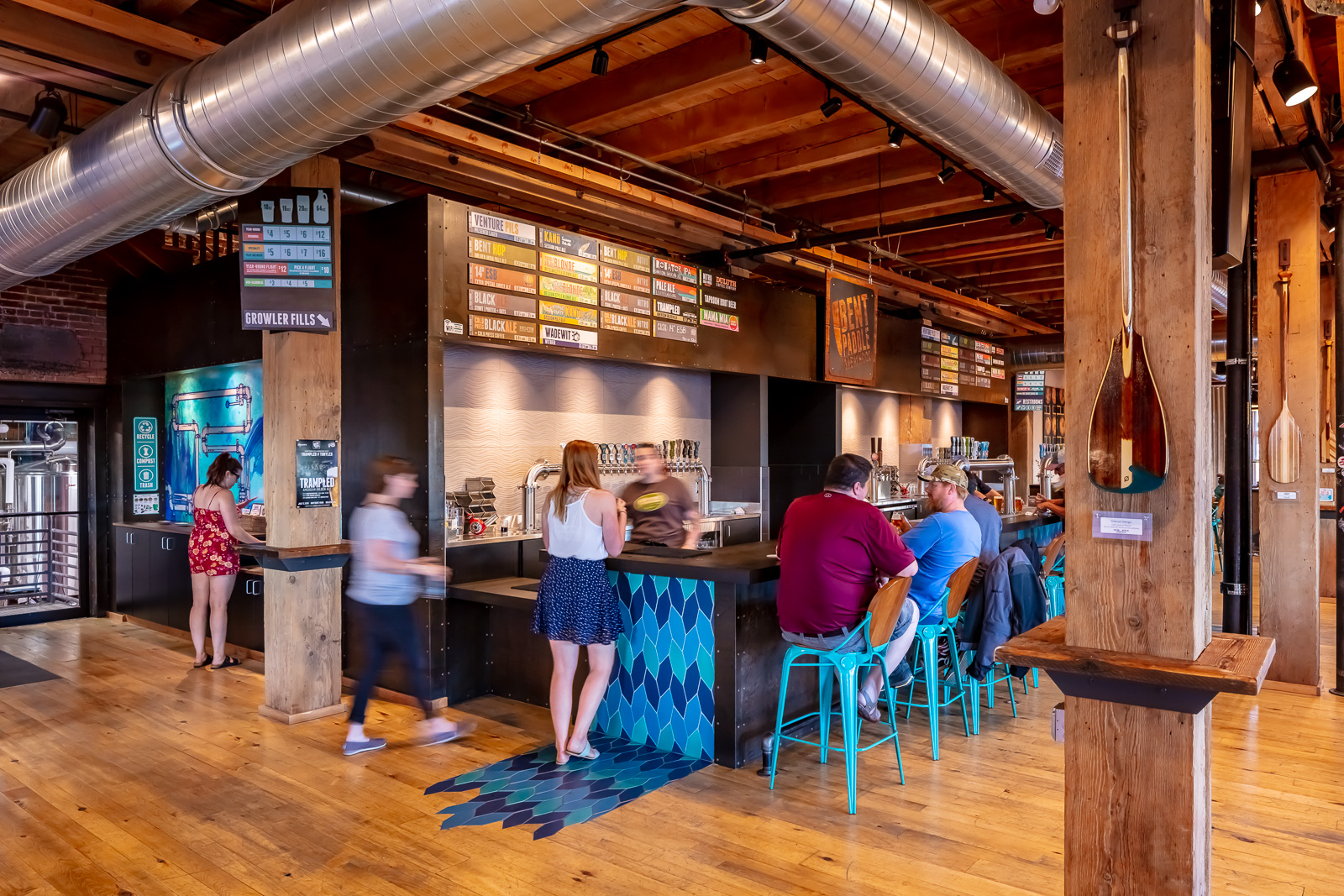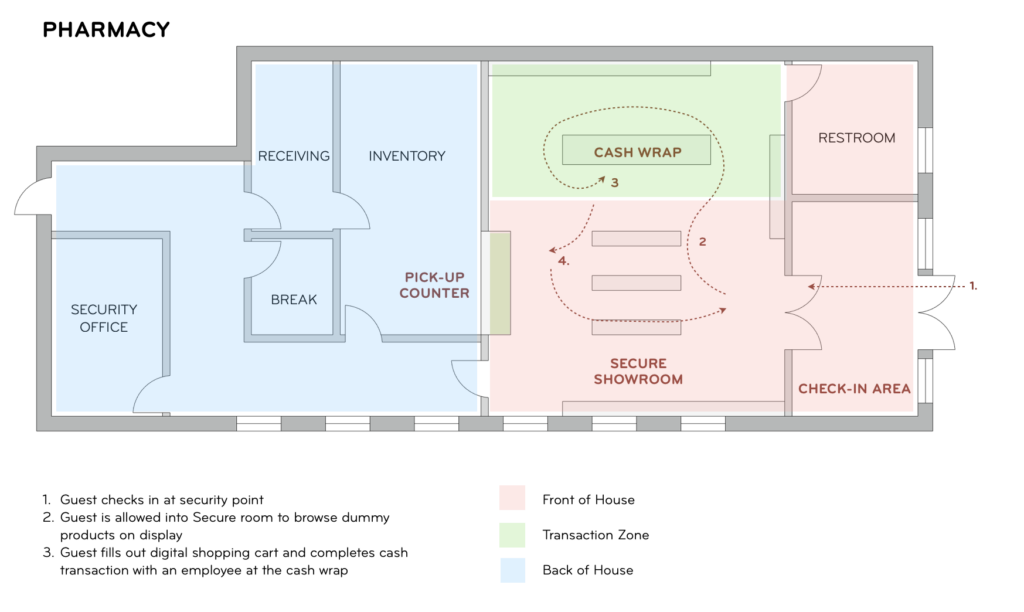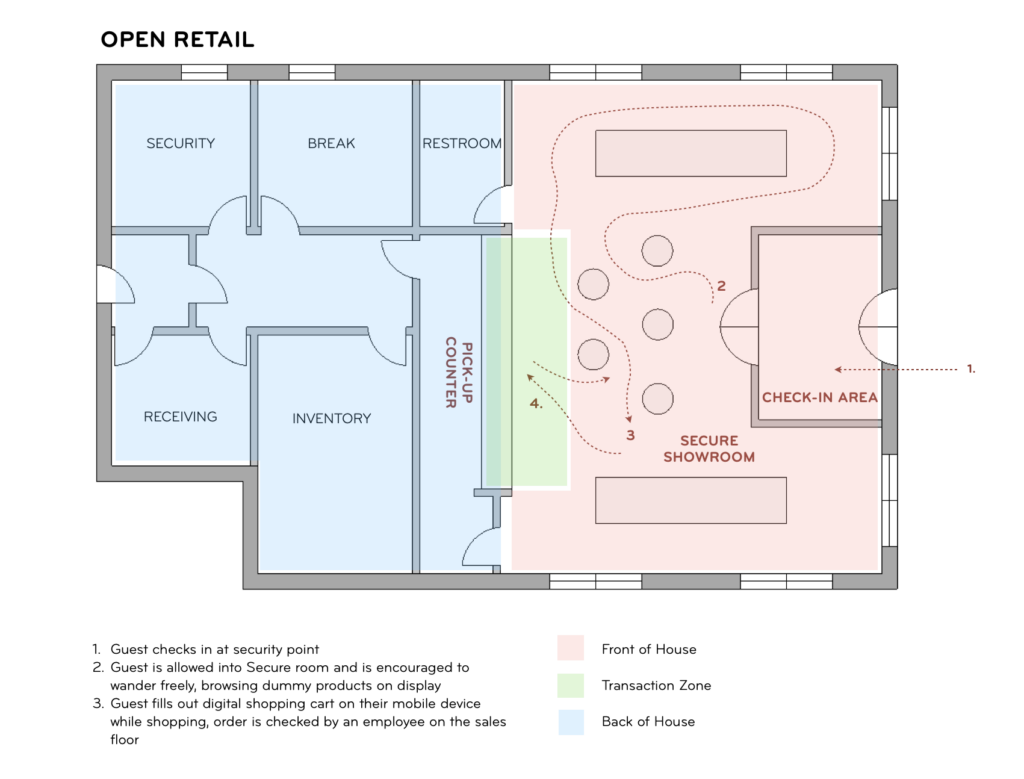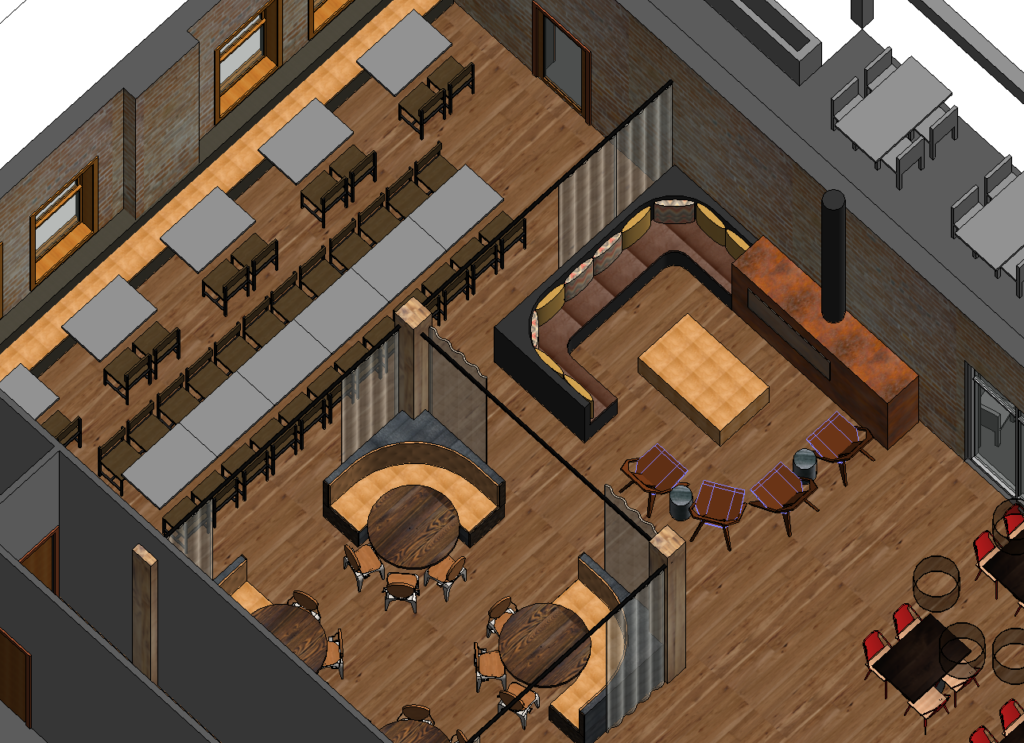
Cannabis retail design 101
The recent legalization of cannabis consumption and sales in Minnesota creates opportunities to transform the way users experience dispensaries through design, architecture and branding. As new cannabis retailers emerge throughout the state, businesses will need to make design decisions around how their products are displayed and purchased, how their back of house is organized, and how their customers will experience the space.
A primary consideration for cannabis entrepreneurs will be the customer experience: how people move through the space, interact with products, and engage with employees. For these types of design decisions, there are a number of retail dispensary layouts already in place across the country, each requiring varying levels of staffing, security measures and product displays — and all can be strategically parsed out with design professionals. Additional attention to branding, product design, packaging, in-store marketing and point-of-sale installations will be required and can also be supported throughout the design process to develop a business that stands out in this up-and-coming market.1
Current (CBD and low-potency THC) dispensaries in MN
Several established dispensaries across the state of Minnesota already sell CBD and low-potency THC products derived from hemp. But, as legislation surrounding cannabis use and distribution changes, so will dispensary storefronts and layouts.
Cannabis retailers will need to implement higher security measures, such as a secure waiting room where customers enter, are checked for an ID, and are then allowed into the store to shop. Currently, in local hemp dispensaries around the Twin Cities, customers are permitted to freely walk in and out, shopping without an ID verification. Existing retailers may choose to open a completely separate location for higher potency THC products, or they might remodel their current storefronts to include a security checkpoint.
Not only will the appearance of storefronts change, the interior layouts of the stores themselves will transform, subsequently impacting the customer experience based on design decisions. Here, we review three layouts commonly seen in dispensaries across other states where cannabis has been legalized.
Layout 1: Bank Style
The Bank Style dispensary layout is very common and follows a similar flow to a local bank. In this layout, products are located at stations with their own POS, where the customer selects products and their order is fulfilled on the spot by an employee. Each employee is in charge of managing and restocking their stations’ inventory and being equipped with adequate knowledge of the store’s inventory, so they can suggest certain products and educate shoppers on various strains, methods of use, etc. This model provides a one-to-one shopping experience between cannabis experts and consumers.2

Layout 2: Pharmacy Style
The Pharmacy Style layout provides a similar customer experience to the bank layout’s, as well as inventory advantages. In this design, the customer is encouraged to wander around the store and browse products located in locked display cases. An employee meets them on the sales floor with a tablet or handheld device to fill a digital shopping cart with what the customer wants. Once the customer is done shopping, the employee completes the sales transaction and the order is fulfilled in the secured back of house. This layout may be favorable for its inventory control and specialized employees, as certain employees are specifically trained in customer service and cash handling on the sales floor, while others handle inventory in the back of house.2

Layout 3: Open Retail
The Open Retail layout is the setup most often found in CBD and low-potency THC shops across Minnesota. It is the most experiential for customers, but has higher operating costs as a result. In this model, dummy products are displayed, or products are locked in cases, so customers can fill their own digital shopping cart from a QR code or link on their phone as they browse. Employees will then check and enter the customer’s order on the sales floor for it to be filled in the back of house.2 The guest checks out at a centralized pay station and receives their order. This model often requires increased staffing to accommodate customers throughout the shopping experience, but maintaining a clear walking path through the space encourages shoppers to look at all products, creating more opportunities to drive impulse purchases.

Additional space considerations: Consumption Lounge
Social consumption lounges — also known as cannabis lounges — are retail lounges that permit on-site cannabis consumption.3 These lounges, separate from the retail space, are becoming increasingly popular in legal cannabis markets and can be an additional square footage for up and coming dispensaries to consider building into their business model.
Based on precedents from other legalized states, including California and Illinois, on-site consumption lounges yield benefits to both cannabis entrepreneurs and consumers. This brewery-taproom style space provides consumers a physical place to consume cannabis safely and legally. With consumers traveling from out of state to consume cannabis in Minnesota, providing customers a safe space to consume the cannabis items they’ve purchased will be important, as it is still federally illegal to cross state lines with the products.
In many of these existing consumption lounges, customers must be 21 or older to enter, and all cannabis consumed must be purchased from the lounge on the same day. Customers are allowed to bring their own rolling papers, lighters and matches, and other outside accessories are not typically permitted but are available for rental in the lounge. On-site consumption lounges are an added opportunity to engage customers and encourage repeat purchases, help destigmatize cannabis, promote social connection, facilitate industry partnerships, and accelerate product innovation.3

Strong design partnership is key
The opportunities that exist within the cannabis distribution and consumption spaces are endless, particularly when it comes to the design of these locations. Creating a unique storefront and customer experience makes a business more recognizable, memorable and personal for consumers. These design choices will be critical, both for retailers already operating in Minnesota who want to make updates to their locations, and for new entrepreneurs venturing into the industry post-legalization.
Decisions can be strategized and executed with a strong design partner. Thought leadership from seasoned professionals around store layout and customer experience will be key. Shelter Architecture has a broad range of experience designing retail, restaurant, and hospitality spaces. Our expertise is highly relevant for cannabis businesses looking to create innovative spaces. We’re excited to have conversations about these kinds of projects. Contact us to connect.
Related Shelter projects
Got questions about design for a cannabis-based business? Want to engage in conversation about this emerging topic? Contact us. We’d love to hear from you!
Resources
1Coskey, Katelyn. “Cannabis Retail Design & Branding: A Beautiful, Budding Relationship.” Point Seven Group:, May 29, 2022. https://pointsevengroup.com/post/cannabis-retail-design-and-branding/.
2Yoo, Melinda. “Member Blog: 2023 Retail Dispensary Design – Three Ways to Layout Your Space |.” The National Cannabis Industry Association, February 7, 2023. https://thecannabisindustry.org/member-blog-2023-retail-dispensary-design-three-ways-to-layout-your-space/.
3Perkins, Dede. “Social Consumption: The Time Is Now.” Cannabis Industry Journal, December 14, 2021. https://cannabisindustryjournal.com/feature_article/social-consumption-the-time-is-now/.
4“Cannabis Dispensary Design Ideas & Layouts for Retail Stores.” Flowhub. Accessed August 24, 2023. https://flowhub.com/dispensary-design.
Related Posts
Sustainable design can serve your cannabis business
When budding cannabis entrepreneurs think green, they often have more than plants and profits in mind. As business owners prepare…
Read moreGetting into the cannabis game? You’ll need a team.
Now that Minnesota has legalized recreational cannabis, we expect a number of new local businesses to crop up. Ventures could…
Read moreCannabis businesses will benefit from design expertise
Today, Minnesota joins 22 other states — plus the District of Columbia and two U.S. territories (Guam and the Northern…
Read more